
The Japanese sea lion was an aquatic mammal that became extinct in the 1970s. It was considered to be a subspecies of the related California sea lion until 2003. They inhabited the Sea of Japan, especially around the coastal areas of the Japanese Archipelago and the Korean Peninsula. They generally bred on sandy beaches which were open and flat, but sometimes in rocky areas. They were hunted commercially in the 1900s, leading to their extinction.
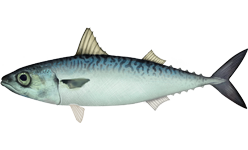
The chub mackerel, Pacific mackerel, or Pacific chub mackerel is a species of fish in the tuna and mackerel family, Scombridae. This species of mackerel closely resembles the Atlantic chub mackerel.

The warbling white-eye, also known as the Japanese white-eye and mountain white-eye, is a small passerine bird in the white-eye family. The specific epithet is occasionally written japonica, but this is incorrect due to the gender of the genus. Its native range includes much of East Asia, including the Russian Far East, Japan, Indonesia, Korea, and the Philippines. It has been intentionally introduced to other parts of the world as a pet and as pest control, with mixed results. As one of the native species of the Japanese islands, it has been depicted in Japanese art on numerous occasions, and historically was kept as a cage bird.

The Japanese giant salamander is a species of salamander in the family Cryptobranchidae. This fully aquatic salamander is endemic to Japan, where it is known as Ōsanshōuo (オオサンショウウオ/大山椒魚), literally meaning "giant salamander". Other local names include Hanzaki,Hanzake, and Ankou. With a length of up to 5 feet (1.5 m), it is the third-largest salamander in the world, only being surpassed by the very similar and closely related Chinese giant salamander and South China giant salamander. There are currently only five known members of the family Cryptobranchidae: the Japanese, Chinese, and South China giant salamanders, an undescribed Andrias species from eastern China, and the hellbender in the eastern United States.

The Japanese sawshark is a species of sawshark in the family Pristiophoridae. This shark has a long, narrow rostrum. Its first dorsal fin originates behind the tips of the pectoral fins, and its caudal fin is angled almost straight in line with the body. The Japanese sawshark reaches a maximum length of up to 1.36 m.

The Japanese wobbegong is a carpet shark in the family Orectolobidae of the wobbegong family, found in the tropical western Pacific Ocean from Japan and Korea to Viet Nam and the Philippines, between latitudes 43 and 6°N. It reaches a length of 1 m. Japanese wobbegong sharks typically remain motionless during the daytime, and are not active hunters. They use camouflage and their electroreceptor pores on their dorsal area to help them sense prey nearby.
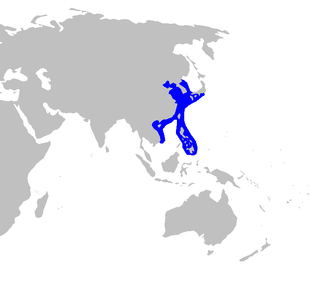
The Japanese spurdog is a dogfish, a member of the family Squalidae. It is found in the western Pacific Ocean – southeastern Japan and the East China Sea, including the Republic of Korea, the Philippines, and the Arafura Sea.

The Japanese roughshark is a rare species of shark in the family Oxynotidae, known only from a handful of specimens recovered from Suruga Bay and the Enshunada Sea off Japan. It is a benthic species that occurs at a depth of 150–350 m (490–1,150 ft). This shark is caught as bycatch by bottom trawlers throughout its entire limited range, and may be threatened given the declines in other bottom deep sea species in Suruga Bay.
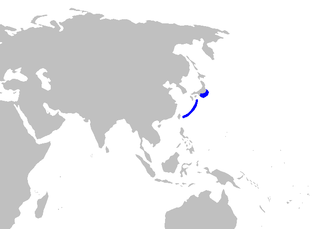
The Japanese catshark is a catshark of the family Scyliorhinidae, found in the northwest Pacific off Chiba Prefecture, Honshū, Japan, between 36 and 34°N. This shark has a relatively slender body, with the trunk tapering towards the head. Its snout is moderately long, bell-shaped, and broad; the preoral snout is about 7 to 8% of total its length. It has large gill slits, rather small eyes in adults, nostrils fairly broad, and a long broad, arched mouth. It is commonly taken by trawl off the type locality, and possibly used for oil, human consumption, and fishmeal or fish cakes locally.
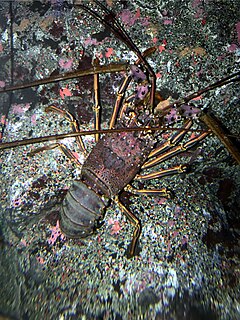
The Japanese spiny lobster, Panulirus japonicus, is a member of the genus Panulirus of spiny lobsters. It grows up to 30 centimetres (12 in) long and lives in the Pacific Ocean around Japan, Taiwan, China, and Korea. P. japonicus is the subject of commercial lobster fishery in Japan. It is a popular item in high-class Japanese cuisine. Serving and preparation methods include sashimi, as a steak, frying, and roasting alive.
Cellvibrio is a genus of Gammaproteobacteria. The cells are slender curved rods. Cellvibrio is Gram-negative.

Parribacus japonicus, the Japanese mitten lobster, is a species of slipper lobster. Though the common name for this lobster is the Japanese mitten lobster, it is locally called zōri-ebi (ゾウリエビ) – zōri denoting the Japanese sandal it resembles, and ebi meaning shrimp or lobster.
In molecular biology, glycoside hydrolase family 43 is a family of glycoside hydrolases.

Marsupenaeus is a monotypic genus of prawn. It contains a single species, Marsupenaeus japonicus, known as the kuruma shrimp, kuruma prawn, or Japanese tiger prawn. It occurs naturally in bays and seas of the Indo-West Pacific, but has also reached the Mediterranean Sea as a Lessepsian migrant. It is one of the largest species of prawns, and is accordingly one of the most economically important species in the family.
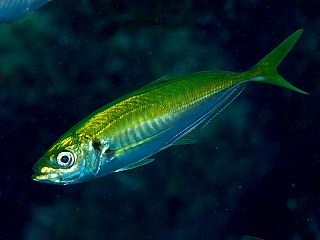
The Japanese jack mackerel, also known as the Japanese horse mackerel or Japanese scad, is a species named after its resemblance to mackerel but which is in the family Carangidae, the jacks, pompanos, trevallies and scads. Their maximum reported length is 50 cm (20 in) with a common length of 35 cm (14 in). They have a maximum reported weight of 0.66 kg (1.5 lb) and a maximum reported age of 12 years. They are found around the coast of Japan, apart from Okinawa Island, usually on sandy bottoms of 50–275 m (164–902 ft) deep. They feed mainly on small crustaceans such as copepods, and shrimps and small fish. They are similar to the yellowtail horse mackerel around New Zealand and Australia, apart from having more gill rakers and larger eyes.

Mallotusinic acid is a hydrolysable tannin found in the bark of Mallotus japonicus. It is more generally present in Geraniales.
Flavobacterium frigidarium is a bacterium. It is an aerobic, psychrophilic, xylanolytic and laminarinolytic bacterium from Antarctica. It is gram-negative, non-motile and yellow-pigmented. Its type strain is A2iT.

The eastern buzzard or Japanese buzzard is a medium to large bird of prey that is sometimes considered a subspecies of the widespread common buzzard. Some scientists treated is as a distinct species starting in 2008, but others still treat it as either one or three subspecies. It is native to Mongolia, China, Japan and some offshore islands. At least some birds winter in Southeast Asia. It is similar to the steppe buzzard.
Cellvibrio zantedeschiae is a Gram-negative, strictly aerobic and motile bacterium from the genus of Cellvibrio which has been isolated from the roots of the plant Zantedeschia aethiopica from Taiwan.
Cellvibrio fibrivorans is a bacterium from the genus of Cellvibrio which has been isolated from soil from a Botanic garden in Ghent in Belgium.